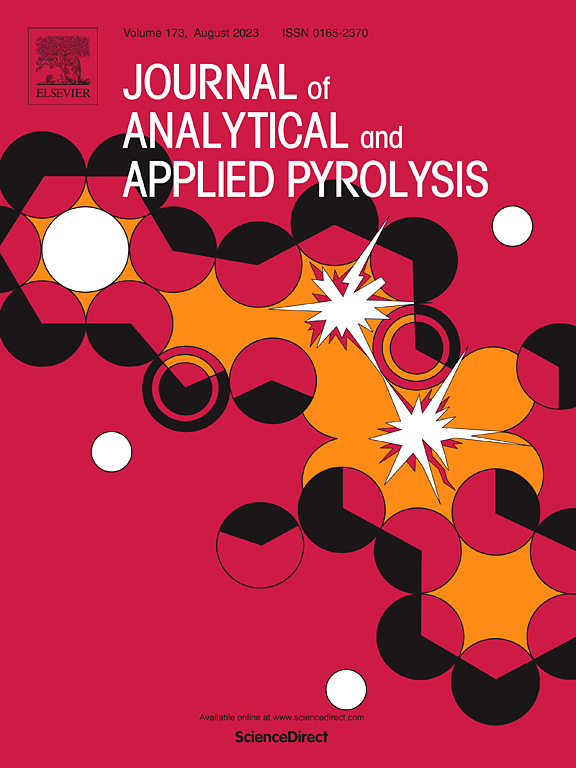Effects of different olefinic active species on molecular growth of heavy aromatic fraction in deep processing of thermally cracked oil
IF 6.2
2区 化学
Q1 CHEMISTRY, ANALYTICAL
引用次数: 0
Abstract
Although highly reactive olefinic species are abundant in thermally cracked oil, previous studies have predominantly focused on the macroscopic fouling effects of aliphatic olefins during transportation/storage. In contrast, the molecular-level mechanisms by which aromatic olefins promote coking during thermal conversion remained unclear. This work systematically investigated how aromatic olefins drive molecular growth and coke formation of heavy aromatic fractions. Thermal conversion experiments with vacuum residue (VR), resins (Re), and asphaltenes (Asp) mixed with olefin model compounds revealed that aromatic olefins accelerated coking compared to aliphatic olefins, with the coking-promoting effect intensifying as the number of aromatic rings in the molecule increased. At 410°C for 60 min, the addition of 5 wt% 9-vinylanthracene to VR increased the coke yield from 1.35 wt% to 5.72 wt%, versus 1.68 wt% with the addition of 5 wt% 1-octene. Similarly, the addition of 5 wt% 9-vinylanthracene elevated the coke yields for Re and Asp systems from 0.66 wt% and 41.28 wt% to 5.13 wt% and 50.84 wt%, respectively, compared to 1.08 wt% (Re) and 43.36 wt% (Asp) observed with the addition of 1-octene. Model compound system studies demonstrated that, aromatic olefins, unlike 1-octene, could further react with primary addition products formed by their initial co-addition with conventional aromatics, leading to the formation of secondary and high-order addition products. Notably, aromatic olefins exhibited increasing reactivity in continuous co-addition reactions as the number of aromatic rings increased. This was supported by 42.2 % high-order addition products detected in the toluene/9-vinylanthracene system versus 30.1 % in the toluene/styrene system. This study elucidated that aromatic olefin promoted molecular growth through continuous co-addition reactions, ultimately triggering phase separation and coke formation. The findings provided molecular-level insights into the adverse impacts of aromatic olefins on industrial processing of thermally cracked oil.
不同烯烃活性物质对热裂解油深加工重芳烃馏分分子生长的影响
尽管热裂解油中含有丰富的高活性烯烃,但以往的研究主要集中在脂肪族烯烃在运输/储存过程中的宏观污染效应。相比之下,芳烃在热转化过程中促进焦化的分子水平机制仍不清楚。这项工作系统地研究了芳烃如何驱动重芳烃馏分的分子生长和焦炭形成。用真空渣油(VR)、树脂(Re)和沥青烯(Asp)与烯烃模型化合物混合进行的热转化实验表明,芳香烯烃比脂肪烯烃加速焦化,并且随着分子中芳烃环数的增加,促进焦化的作用增强。在410°C、60 min下,向VR中加入5 wt%的9-乙烯基蒽使焦炭收率从1.35 wt%提高到5.72 wt%,而加入5 wt%的1-辛烯则使焦炭收率从1.68 wt%提高到1.35 wt%。同样,添加5 wt%的9-乙烯基蒽将Re和Asp体系的焦炭收率分别从0.66 wt%和41.28 wt%提高到5.13 wt%和50.84 wt%,而添加1-辛烯时的焦炭收率分别为1.08 wt% (Re)和43.36 wt% (Asp)。模型化合物体系研究表明,芳香烯烃与1-辛烯不同,可以与常规芳烃初始共加成后的一级加成产物进一步反应,生成二级加成产物和高阶加成产物。值得注意的是,芳香烯烃在连续共加成反应中的反应活性随着芳香环数的增加而增加。在甲苯/9-乙烯基蒽体系中检测到的高阶加成产物为42.2% %,而在甲苯/苯乙烯体系中检测到的高阶加成产物为30.1% %。本研究阐明了芳烃通过连续的共加成反应促进分子生长,最终引发相分离和焦炭生成。这些发现为芳烯烃对热裂解油工业加工的不利影响提供了分子水平的见解。
本文章由计算机程序翻译,如有差异,请以英文原文为准。
求助全文
约1分钟内获得全文
求助全文
来源期刊
CiteScore
9.10
自引率
11.70%
发文量
340
审稿时长
44 days
期刊介绍:
The Journal of Analytical and Applied Pyrolysis (JAAP) is devoted to the publication of papers dealing with innovative applications of pyrolysis processes, the characterization of products related to pyrolysis reactions, and investigations of reaction mechanism. To be considered by JAAP, a manuscript should present significant progress in these topics. The novelty must be satisfactorily argued in the cover letter. A manuscript with a cover letter to the editor not addressing the novelty is likely to be rejected without review.

 求助内容:
求助内容: 应助结果提醒方式:
应助结果提醒方式:


